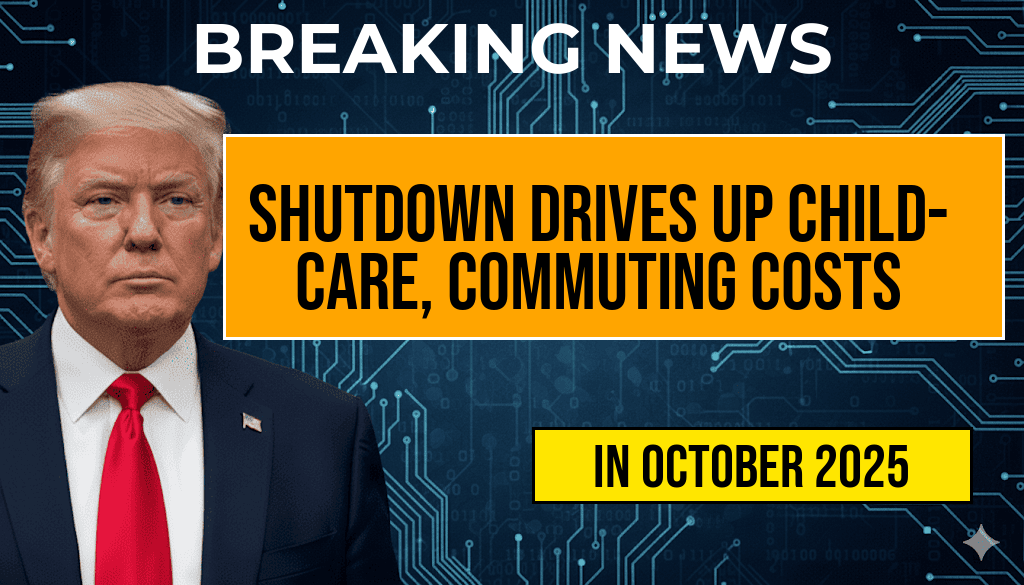The ongoing government shutdown is causing significant financial strain for families in the Washington, D.C. area, particularly in terms of child-care costs and commuting expenses. As federal workers face uncertainty, many are grappling with rising prices for essential services. The National Association of Child Care Resource & Referral Agencies reports that child-care costs in the region have surged by up to 20% since the start of the shutdown. Simultaneously, commuting expenses have escalated due to increased tolls and public transportation fare hikes, further burdening families already stretched thin by the financial impacts of the shutdown. As lawmakers continue to debate a resolution, many residents are left to navigate a precarious economic landscape, questioning how long they can sustain these added expenses.
Rising Child-Care Costs
Child-care facilities across the D.C. region are feeling the pinch as parents struggle to afford services. A survey conducted by the Child Care Aware of America indicates that many providers have raised their rates to compensate for lost funding and increased operational costs. This situation is particularly dire for families with multiple children or those requiring full-time care.
- Average monthly costs: Families report paying as much as $1,800 for infant care, up from $1,500 last year.
- Increased demand: Many parents are forced to seek alternative arrangements, leading to overcrowded facilities.
- Quality concerns: With rising costs, some parents worry about the quality of care as facilities struggle to maintain staff levels.
Commuting Expenses on the Rise
Alongside child-care challenges, commuting costs have surged for many D.C. residents. The Washington Metropolitan Area Transit Authority (WMATA) has increased fares by an average of 10%, affecting those who rely on public transportation to reach their jobs. Additionally, tolls on major highways have seen similar hikes, leading to increased daily costs for drivers.
| Type of Commuting | Before Shutdown | After Shutdown |
|---|---|---|
| Metro Fare (Round Trip) | $5.00 | $5.50 |
| Average Toll (I-66) | $4.00 | $4.50 |
| Bus Fare (Round Trip) | $3.00 | $3.30 |
Effects on Families and Local Economy
The compounded effects of rising child-care and commuting costs are having a ripple effect on local families and the broader economy. Many parents are either cutting back on work hours or leaving their jobs entirely due to unaffordable child-care options. This trend is exacerbated by the uncertainty surrounding the government shutdown, which has already affected various sectors.
- Job market impacts: Local businesses report a decrease in productivity as parents juggle work and rising costs.
- Reduced spending: Families are tightening their budgets, which could slow local economic growth.
- Emotional toll: The stress of rising expenses is taking a mental and emotional toll on families, particularly single parents.
Looking Ahead
As the government shutdown continues with no end in sight, many families are left to wonder how long they can endure these escalating costs. Advocacy groups are calling for immediate relief measures, including subsidies for child care and public transportation. Policymakers are urged to prioritize these issues in negotiations to mitigate the financial burden on families in the D.C. region.
The current situation serves as a stark reminder of the interconnectedness of public policy and personal finance. As discussions unfold, the hope is for a resolution that supports working families and alleviates the pressures they face during this challenging time. For further information on the impacts of the shutdown, visit Forbes and The Washington Post.
Frequently Asked Questions
What is the main reason for the increase in child-care costs during the government shutdown?
The main reason for the increase in child-care costs during the government shutdown is the reduction in funding for federal programs that support affordable child care, leading to higher expenses for families who rely on these services.
How has the government shutdown affected commuting expenses in the DC region?
The government shutdown has led to increased commuting expenses due to higher fuel prices and the need for alternative transportation methods as public transit services face budget cuts and reduced operations.
Are there any resources available for families struggling with child-care costs during the shutdown?
Yes, families can access various resources, including local non-profits and community organizations that offer financial assistance or subsidized child-care options during the government shutdown.
What long-term effects might the government shutdown have on child-care services?
The long-term effects of the government shutdown on child-care services may include decreased availability of affordable options, increased costs for families, and potential job losses for child-care providers due to reduced funding and enrollment.
How can commuters in the DC region mitigate rising commuting costs during the shutdown?
Commuters can mitigate rising commuting costs by exploring carpooling options, utilizing public transportation when available, and considering flexible work arrangements such as remote work to reduce travel frequency.










